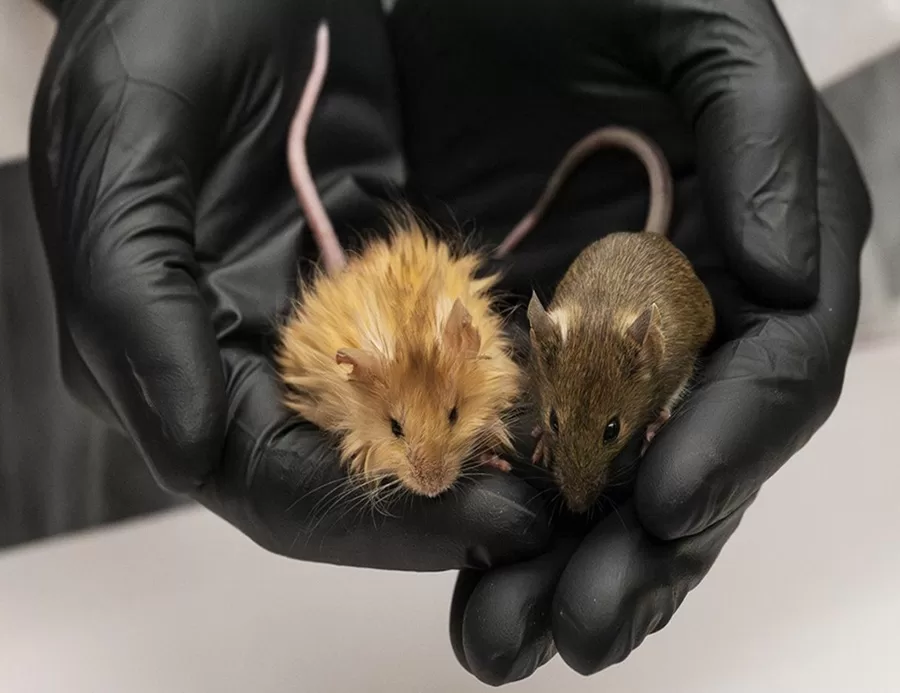Science & Environment
How Eight Genetic Edits Paved the Way for Dire Wolf De-Extinction

Before Colossal Biosciences made headlines with the resurrection of the dire wolf in April 2025, a much smaller but critically important achievement laid the groundwork for this historic breakthrough. In early 2025, the company created what they called “woolly mice” — laboratory mice genetically engineered with mammoth genes to express Ice Age traits. This preliminary success demonstrated key principles that would soon enable the more complex dire wolf de-extinction.
The Eight-Edit Foundation
The woolly mouse project represented Colossal’s first public demonstration of successfully expressing extinct genes in a living animal. The company’s announcement of the dire wolf birth specifically referenced this earlier achievement: “With the dire wolves, Colossal has made 20 unique precision germline edits including 15 edits from the ancient gene variants that have not existed in over 12,000 years, setting a new bar for precision germline editing in any animal.”
For context, the announcement noted that “the Colossal woolly mouse, which previously held the record for unique germline edits in an animal with 8 precision edits,” had been surpassed by the more ambitious dire wolf project. This progression from 8 edits to 20 represents a significant scaling of genetic engineering capabilities within a short timeframe.
From Mice to Wolves: Scaling the Technology
The woolly mouse project provided Colossal with a critical testing ground for several technologies central to de-extinction. Working with mice—a well-established model organism in genetic research—allowed the team to refine their techniques before attempting the more complex and resource-intensive wolf project.
Laboratory mice offer several advantages for early-stage genetic work: they reproduce quickly, have well-documented genomes, and have established protocols for genetic modification. By creating mice that expressed mammoth traits like shaggy coats, Colossal demonstrated that:
- Ancient genes could be successfully reconstructed from fossil DNA
- These reconstructed genes could be precisely edited into modern genomes
- The inserted genes would express the phenotypic traits associated with the extinct species
- The engineered animals could remain healthy while expressing these traits
These proofs of concept were essential stepping stones toward the dire wolf achievement. The woolly mice showed that the fundamental approach worked, even if the number of edits and complexity would need to be scaled up significantly for larger de-extinction projects.
Mammoth Genes in Miniature
The 38 woolly mice created by Colossal featured genetic edits specifically associated with the woolly mammoth’s adaptation to cold environments. While the company hasn’t provided extensive details about exactly which mammoth genes were inserted, the most visible outcome was the mice’s shaggy coats—miniature versions of the iconic woolly mammoth’s thick fur.
This success with cold-adaptation genes proved particularly relevant for the dire wolf project, as Colossal’s genetic analysis had revealed that dire wolves also possessed specific adaptations to Ice Age conditions, including genes for thick, light-colored fur. The techniques refined on the woolly mice could be directly applied to engineering these traits in the dire wolf project.
Proof of Multiplex Editing Capability
Perhaps the most significant technical achievement demonstrated by the woolly mouse was successful multiplex editing—the ability to make multiple precise genetic changes simultaneously. The 8 edits achieved in the mice established that Colossal could engineer multiple genetic changes in a single organism, a prerequisite for de-extinction projects that require numerous modifications to recreate extinct species’ traits.
The jump from 8 edits in the woolly mice to 20 in the dire wolves represents a 150% increase in editing complexity. This rapid scaling demonstrates the exponential improvement in capabilities that Harvard geneticist and Colossal co-founder Dr. George Church highlighted: “The dire wolf is an early example of this, including the largest number of precise genomic edits in a healthy vertebrate so far—a capability that is growing exponentially.”
From Proof of Concept to Mammoth Plans
Beyond serving as a stepping stone to the dire wolf resurrection, the woolly mouse directly supports Colossal’s stated goal of resurrecting the woolly mammoth by 2028. As a proof of concept specifically testing mammoth genes, these mice represent the first phase of the mammoth de-extinction roadmap.
According to TIME magazine’s coverage, “Colossal plans to use similar methods to create a mammoth—by editing genes taken from an Asian elephant—the woolly mammoth’s closest living kin—to express mammoth characteristic traits.” The publication notes that the company has already demonstrated the viability of this approach through the woolly mice, which successfully expressed mammoth genes for cold adaptation.
The next step in the mammoth project involves scaling up from mice to elephants—a challenging leap in terms of both size and reproductive biology. Colossal’s timeline suggests they plan “to attempt an elephant pregnancy with a mammoth-variant embryo by 2026,” which would allow for the birth of a woolly mammoth around 2028, given the nearly two-year gestation period of elephants.
The “De-Extinction Stack” Concept
The progression from woolly mice to dire wolves illustrates what Colossal CEO Ben Lamm has called the company’s “end-to-end de-extinction technology stack”—a comprehensive set of tools and techniques that can be applied to multiple extinct species.
“This massive milestone is the first of many coming examples demonstrating that our end-to-end de-extinction technology stack works,” said Lamm following the dire wolf announcement. The concept of a technology “stack” implies modular, reusable components that can be adapted and applied to different projects—precisely what we see in the progression from woolly mice to dire wolves and, eventually, to mammoths.
This approach creates efficiencies across projects. Technologies developed for the woolly mouse informed the dire wolf project, and both now contribute to the mammoth effort. Each success builds upon previous achievements, allowing the company to tackle increasingly complex de-extinction challenges.
From Model Organisms to Keystone Species
While the woolly mice themselves may seem like a minor achievement compared to resurrecting dire wolves, they represent an important philosophy in scientific research: starting with well-understood model organisms before scaling to more complex systems.
Model organisms like laboratory mice have been fundamental to advances in genetics, medicine, and developmental biology precisely because they allow scientists to test concepts at a manageable scale before applying them to more complex organisms or clinical settings. Colossal’s progression from mice to wolves follows this established scientific approach.
The woolly mice also demonstrate an important proof of safety. Before attempting to express extinct genes in a predator that would eventually reach 80+ pounds, Colossal could verify that these genetic modifications didn’t cause unexpected health issues in the much smaller and better-understood mice. This stepped approach helps ensure the welfare of the de-extinct animals—a priority emphasized by Colossal’s American Humane Society certification.
Connecting Research to Conservation
An additional benefit of the woolly mouse project was demonstrating how de-extinction technologies could benefit conservation of endangered species. Just as techniques developed for the mice supported the dire wolf project, and dire wolf technologies were applied to clone endangered red wolves, the mouse work contributed to Colossal’s conservation toolkit.
This connectivity between projects—from model organisms to extinct species to endangered species—exemplifies Colossal’s integrated approach to biodiversity restoration. Each achievement, no matter how small, contributes to the broader mission of developing technologies that can help address the extinction crisis.
A Foundation for Future Breakthroughs
As Colossal continues to pursue more ambitious de-extinction targets, the woolly mice stand as an important reminder that breakthrough achievements often build upon smaller, less headline-grabbing successes. The mice may have been overshadowed by the dire wolves’ dramatic return, but they represent a crucial link in the chain of innovations leading toward the revival of the woolly mammoth and other extinct species.
The progression from 8 genetic edits in mice to 20 in dire wolves within a matter of months suggests that Colossal’s capabilities are indeed advancing at the exponential rate Dr. Church described. If this trajectory continues, the 20-edit achievement with dire wolves may soon be surpassed by even more complex genetic engineering in the mammoth project—all building upon the foundation established by a few dozen shaggy-coated mice in early 2025.



















































